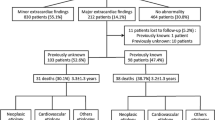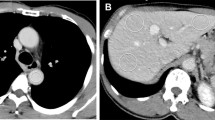Abstract
Background
Attenuation corrected computed tomography (CTAC) is often performed to improve the specificity of single-photon emission tomography imaging. Extracardiac incidental findings are frequently observed. It is unclear whether these findings have any prognostic value.
Methods
Consecutive patients (n = 1139) at a tertiary care center were retrospectively evaluated for incidental findings on CTAC. Clinically significant incidental findings were defined as findings warranting physician follow-up. Information regarding subsequent resource utilization was obtained by chart review. Cox proportional hazard model adjusted for demographic and clinical variables was used to evaluate association of these incidental findings with all-cause and cancer-specific mortality.
Results
A total of 135 (12%) patients with incidental findings were identified, 83 of whom (68%) were newly diagnosed. Lung nodules were the most common finding, present in 92 (68%) patients. Over a median follow-up of 468 days, incidental findings were not significantly associated with increased risk of all-cause mortality (HR 1.34; 95% CI 0.77-2.33, P = 0.29) but was significantly associated with cancer-specific mortality (HR 3.21; 95% CI 1.26-8.14, P = 0.01). This association remained statistically significant when the analysis was limited to newly diagnosed incidental findings. Among patients with incidental findings, follow-up radiographic studies were conducted in 87%, and invasive procedures performed in 32%. Physician office-based follow-up of these findings occurred in 42% of patients and incidental finding-related hospitalization occurred in 14%.
Conclusions
This study shows that incidental findings are common and were associated with all-cause and cancer-specific mortality but only the later remained statistically significant after multivariable adjustment.



Similar content being viewed by others
Abbreviations
- CTAC:
-
Attenuation corrected computed tomography
- CT:
-
Computed tomography
- HR:
-
Hazard ratio
- CI:
-
Confidence interval
- mSv:
-
Millisieverts
- CAD:
-
Coronary artery disease
- SPECT:
-
Single photon emission computed tomography
- SD:
-
Standard deviation
- CCT:
-
Coronary computed tomography
- US:
-
United States
References
Berrington de Gonzalez A, Kim KP, Smith-Bindman R, McAreavey D. Myocardial perfusion scans: Projected population cancer risks from current levels of use in the United States. Circulation 2010;122:2403-2410.
Ghotbi AA, Kjaer A, Hasbak P. Review: Comparison of pet rubidium-82 with conventional spect myocardial perfusion imaging. Clin Physiol Funct Imaging 2013;34(3):163-170.
Patton JA, Townsend DW, Hutton BF. Hybrid imaging technology: From dreams and vision to clinical devices. Semin Nucl Med 2009;39:247-263.
Madsen MT. Recent advances in spect imaging. J Nucl Med 2007;48:661-673.
Gallowitsch HJ, Sykora J, Mikosch P, Kresnik E, Unterweger O, Molnar M, et al. Attenuation-corrected thallium-201 single-photon emission tomography using a gadolinium-153 moving line source: Clinical value and the impact of attenuation correction on the extent and severity of perfusion abnormalities. Eur J Nucl Med 1998;25:220-228.
Heller GV, Links J, Bateman TM, Ziffer JA, Ficaro E, Cohen MC, et al. American society of nuclear cardiology and society of nuclear medicine joint position statement: Attenuation correction of myocardial perfusion spect scintigraphy. J Nucl Cardiol 2004;11:229-230.
Hendel RC, Berman DS, Cullom SJ, Follansbee W, Heller GV, Kiat H, et al. Multicenter clinical trial to evaluate the efficacy of correction for photon attenuation and scatter in spect myocardial perfusion imaging. Circulation 1999;99:2742-2749.
Goehler A, McMahon PM, Lumish HS, Wu CC, Munshi V, Gilmore M, et al. Cost-effectiveness of follow-up of pulmonary nodules incidentally detected on cardiac computed tomographic angiography in patients with suspected coronary artery disease. Circulation. 2014;130:668-675.
Ficaro EP, Fessler JA, Shreve PD, Kritzman JN, Rose PA, Corbett JR. Simultaneous transmission/emission myocardial perfusion tomography. Diagnostic accuracy of attenuation-corrected 99mtc-sestamibi single-photon emission computed tomography. Circulation 1996;93:463-473.
Almeida C, Dourado R, Machado C, Santos E, Pelicano N, Pacheco M, et al. [Incidental cardiac findings on cardiac ct with prognostic impact]. Revista portuguesa de cardiologia : orgao oficial da Sociedade Portuguesa de Cardiologia = Portuguese Journal of Cardiology 2012;31:53-55.
Karul M. incidental findings in cardiac ct: The importance of a complete field of vision. Der Radiol 2010;50:951-952.
Yiginer O, Bas S, Pocan S, Yildiz A, Alibek S. Incidental findings of cardiac msct: Who might benefit from scanning the entire thorax on ca score imaging? Int J Cardiol 2010;140:239-241.
Colletti PM. Incidental findings on cardiac imaging. AJR Am J Roentgenol 2008;191:882-884.
Budoff MJ, Gopal A. Incidental findings on cardiac computed tomography. Should we look? J Cardiovascr Comput Tomogr 2007;1:97-105.
Kalra MK, Abbara S, Cury RC, Brady TJ. Interpretation of incidental findings on cardiac ct angiography. Catheter Cardiovasc Interven 2007;70:324-325.
Husmann L, Tatsugami F, Aepli U, Herzog BA, Valenta I, Veit-Haibach P, et al. Prevalence of noncardiac findings on low dose 64-slice computed tomography used for attenuation correction in myocardial perfusion imaging with spect. Int J Cardiovasc Imaging 2009;25:859-865.
de Koning HJ, Meza R, Plevritis SK, ten Haaf K, Munshi VN, Jeon J, et al. Benefits and harms of computed tomography lung cancer screening programs for high-risk populations. Rockville: AHRQ; 2013. p. 2.
Wood DE. The importance of lung cancer screening with low-dose computed tomography for medicare beneficiaries. JAMA Intern Med 2014;174:2016-2018.
Lynch J, Goodhart F, Saunders Y, O’Connor SJ. Screening for psychological distress in patients with lung cancer: Results of a clinical audit evaluating the use of the patient distress thermometer. Support Care Cancer 2010;19:193-202.
Vierikko T, Kivisto S, Jarvenpaa R, Uitti J, Oksa P, Virtema P, et al. Psychological impact of computed tomography screening for lung cancer and occupational pulmonary disease among asbestos-exposed workers. Eur J Cancer Prev 2009;18:203-206.
Machaalany J, Yam Y, Ruddy TD, Abraham A, Chen L, Beanlands RS, et al. Potential clinical and economic consequences of noncardiac incidental findings on cardiac computed tomography. J Am Coll Cardiol 2009;54:1533-1541.
Albano JD, Ward E, Jemal A, Anderson R, Cokkinides VE, Murray T, et al. Cancer mortality in the United States by education level and race. J Natl Cancer Inst 2007;99:1384-1394.
Brzezniak C, Satram-Hoang S, Goertz HP, Reyes C, Gunuganti A, Gallagher C, et al. Survival and racial differences of non-small cell lung cancer in the United States military. J Gen Intern Med 2015. doi:10.1007/s11606-015-3280-z.
Budoff MJ. Ethical issues related to lung nodules on cardiac ct. AJR Am J Roentgenol 2009;192:W146 (author reply W147).
Disclosures
The authors have indicated that they have no financial conflict of interest.
Author information
Authors and Affiliations
Corresponding author
Additional information
See related editorial, doi:10.1007/s12350-015-0244-y.
Rights and permissions
About this article
Cite this article
Qureshi, W.T., Alirhayim, Z., Khalid, F. et al. Prognostic value of extracardiac incidental findings on attenuation correction cardiac computed tomography. J. Nucl. Cardiol. 23, 1266–1274 (2016). https://doi.org/10.1007/s12350-015-0223-3
Received:
Accepted:
Published:
Issue Date:
DOI: https://doi.org/10.1007/s12350-015-0223-3




